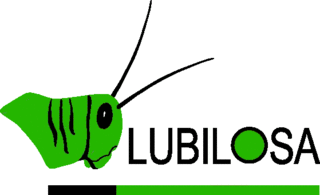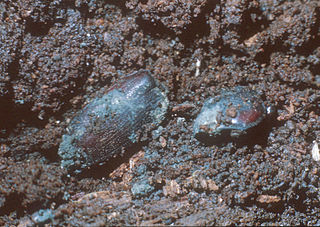
Beauveria bassiana is a fungus that grows naturally in soils throughout the world and acts as a parasite on various arthropod species, causing white muscardine disease; it thus belongs to the group of entomopathogenic fungi. It is used as a biological insecticide to control a number of pests, including termites, thrips, whiteflies, aphids and various beetles. Its use in the control of bed bugs and malaria-transmitting mosquitos is under investigation.

An entomopathogenic fungus is a fungus that can kill or seriously disable insects.
Hyphomycetes are a form classification of fungi, part of what has often been referred to as fungi imperfecti, Deuteromycota, or anamorphic fungi. Hyphomycetes lack closed fruit bodies, and are often referred to as moulds. Most hyphomycetes are now assigned to the Ascomycota, on the basis of genetic connections made by life-cycle studies or by phylogenetic analysis of DNA sequences; many remain unassigned phylogenetically.
Clonostachys rosea f. rosea, also known as Gliocladium roseum, is a species of fungus in the family Bionectriaceae. It colonizes living plants as an endophyte, digests material in soil as a saprophyte and is also known as a parasite of other fungi and of nematodes. It produces a wide range of volatile organic compounds which are toxic to organisms including other fungi, bacteria, and insects, and is of interest as a biological pest control agent.
Raymond J. St. Leger is an American mycologist, entomologist, molecular biologist and biotechnologist who currently holds the rank of Distinguished University Professor in the Department of Entomology at the University of Maryland, College Park.

Metarhizium is a genus of entomopathogenic fungi in the Clavicipitaceae family. With the advent of genetic profiling, placing these fungi in proper taxa has now become possible. Most turn out to be the asexual forms (anamorphs) of fungi in the phylum Ascomycota, including Metacordyceps spp.

LUBILOSA was the name of a research programme that aimed at developing a biological alternative to the chemical control of locusts. This name is an acronym of the French title of the programme: Lutte Biologique contre les Locustes et les Sauteriaux. During its 13-year life, the programme identified an isolate of an entomopathogenic fungus belonging to the genus Metarhizium and virulent to locusts, and went through all the necessary steps to develop the commercial biopesticide product Green Muscle based on its spores.

Metarhizium acridum is the new name given to a group of fungal isolates that are known to be virulent and specific to the Acrididea (grasshoppers). Previously, this species has had variety status in Metarhizium anisopliae ; before that, reference had been made to M. flavoviride or Metarhizium sp. describing an "apparently homologous and distinctive group" of isolates that were most virulent against Schistocerca gregaria in early screening bioassays.

Metarhizium majus is the name given to a group of fungal isolates that are known to be virulent against Scarabaeidae, a family of beetles. Previously, this species has had variety status in Metarhizium anisopliae and its name is derived from characteristically very large spores for the genus Metarhizium. There has been considerable interest in developing isolates of this species into mycoinsecticides: especially against the coconut and oil palm beetle pest Oryctes in SE Asia, the Pacific region and Africa.

Metarhizium flavoviride is a Sordariomycete in the order Hypocreales and family Clavicipitaceae. The genus Metarhizium currently consists of over 70 described species and are a group of fungal isolates that are known to be virulent against Hemiptera and some Coleoptera. M. flavoviride is described as its own species, but there also exists a variety of M. flavoviride, which is M. flavoviride var. flavoviride. Previously described varieties of M. flavoviride have been documented, however recent random amplified polymorphic DNA (RAPD) markers have assigned these varieties as new species. The reassigned species are as follows: M. flavoviride Type E is now M. brasiliense; M. flavoviride var. minus is now M. minus; M. flavoviride var. novozealandicum is now M. novozealandicum; and M. flavoviride var. pemphigi is now M. pemphigi.

Muscardine is a disease of insects. It is caused by many species of entomopathogenic fungus. Many muscardines are known for affecting silkworms. Muscardine may also be called calcino.
Zoophthora is a genus of fungi in the family Entomophthoraceae. Like other taxa in this family, Zoophthora species cause disease in insects and as such are considered entomopathogenic fungi.
Metarhizium brunneum is the re-instated name of a group of reassigned Metarhizium isolates, previously grouped in the species "Metarhizium anisopliae var. anisopliae": based on a multigene phylogenetic approach using near-complete sequences from nuclear DNA. It is a mitosporic fungus with asexual reproduction, which was formerly classified in the form class Hyphomycetes of the form phylum Deuteromycota. M. brunneum has been isolated from Coleoptera, Lepidoptera, Diptera and soil samples, but a commercially developed isolate (below) has proved virulent against Hemiptera and Thysanoptera.
Entomophaga grylli is a fungal pathogen which infects and kills grasshoppers. It is the causal agent of one of the most widespread diseases affecting grasshoppers. This is sometimes known as summit disease because infected insects climb to the upper part of a plant and grip the tip of the stem as they die; this ensures widespread dispersal of the fungal spores. The fungus is a species complex with several different pathotypes, each one of which seems to be host-specific to different subfamilies of grasshoppers. The pathogen is being investigated for its possible use in biological pest control of grasshoppers.
Isaria fumosorosea is an entomopathogenic fungus, formerly known as Paecilomyces fumosoroseus. It shows promise as a biological pesticide with an extensive host range.
Green muscardine disease is the presentation of a fungal infection of insects caused by members of the Metarhizium genus, because of the green colour of their spores. Once the fungus has killed its host, mycelia invade the host's body and, under humid conditions, the insect cuticle becomes covered with a layer of green spores, hence the name of the disease. It was originally discovered as a pest of silk worms, upon which it was highly lethal. To insect mycologists and microbial control specialists, "green muscardine" refers to fungal infection caused by Metarhizium spp., whereas in sericulture, "green muscardine" refers to a similar fungal infection caused by Nomuraea rileyi. Green muscardine has been identified as disease of over 200 known insect species.
Tariq Butt is a British entomologist. He is a Professor of Biosciences at Swansea University in Wales.
Donald W. Roberts was an American insect pathologist and one of the originators of that field. He was especially known for research into biological pest control of Lepidoptera by Metarhizium but also Beauveria bassiana. He was a Research Professor Emeritus in the Biology Department of Utah State University.

Metarhizium anisopliae is the type species in its genus of fungi, that grows naturally in soils throughout the world and causes disease in various insects by acting as a parasitoid. Ilya I. Mechnikov named it Entomophthora anisopliae (basionym) after the insect species from which it was originally isolated – the beetle Anisoplia austriaca and from these early days, fungi such as this have been seen as potentially important tools for pest management. It is a mitosporic fungus with asexual reproduction, which was formerly classified in the form class Hyphomycetes of the phylum Deuteromycota.
Batkoa major is a naturally occurring fungus.





